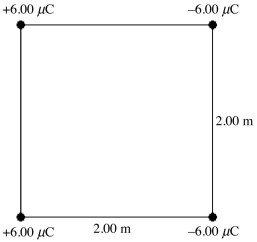Four point charges of magnitude 6.00 μC and of varying signs are placed at the corners of a square 2.00 m on each side, as shown in the figure. (k = 1/4πε0 = 8.99 × 109 N ∙ m2/C2)
(a) What is the electric potential (relative to infinity) at the center of this square due to these charges?
(b) What is the magnitude of the electric field due to these charges at the center of the square? 
Definitions:
Fibrous Connective Tissue
This type of tissue functions mainly for support and protection in the body, consisting largely of bundles of collagen fibers and fibroblasts.
Range of Motion
The complete range of motion accessible within a joint, often defined by its capacity for bending and straightening.
Isometric
Pertaining to muscle contractions where tension is developed without changing the length of the muscle.
Passive
Exhibiting or characterized by non-resistance or submission to external forces or influences.
Q2: The graph in the figure shows the
Q14: Vector <img src="https://d2lvgg3v3hfg70.cloudfront.net/TB4469/.jpg" alt="Vector =
Q15: According to the second law of thermodynamics,
Q15: White light is incident normally on a
Q15: If A > B, under what condition
Q22: The diameter of a 12-gauge copper wire
Q23: A Carnot engine operates between a high
Q43: The spherical side mirror on a car
Q54: When light goes from one material into
Q62: For a long ideal solenoid having a